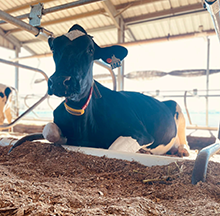How does physical conformation relate to economically important traits in today’s dairy industry? A recent study completed by Holstein Association USA aimed to assess these relationships using linear classification data and DHIA production records. The dataset covered almost 20 years of data and includes over 1 million cows. The results of this study clearly show that cows with more correct, functional conformation live longer and produce more milk.
Linear type classification programs are well established as a method for assessing physical conformation of economically important traits. Cows with higher scores are closer to the ideal physical conformation for a Holstein cow.
Cows included in the analysis were split into quartiles, with an equal number of cows in each quartile (refer to Figure 1). First lactation cows in the top quartile for final classification score (final scores between 82 and 89 points) produced 1,537 pounds more energy corrected milk in 305 days than those in the bottom quartile (76 points and lower). Using a long-term milk price, of $20/cwt, this difference represents $307 more in gross revenue in their first lactation.
Figure 1: First Lactation 305 Day ECM by Final Score Quartile

Looking at lifetime energy-corrected milk (ECM), comparing the top quartile to the bottom quartile, the highest scored cows produced 13,389 more pounds of ECM across their lifetimes than cows in the bottom quartile (refer to Figure 2). Using a long-term milk price, of $20/cwt, this difference represents $2,678 more in gross milk revenue per cow over the course of their lives. Among individual linear classification traits udder and feet and leg traits were most corelated with milk yield and longevity measures. Additionally, when look at lifetime days in milk (DIM), cows in the top quartile for final classification score had 142 more lifetime DIM than cows in the bottom quartile.
Figure 2: Lifetime ECM by Final Score Quartile

This large dataset provides new insight into the importance of physical conformation to production and longevity. These results also show that linear classification does quantify economically important physical conformation traits well. As the dairy industry focuses sustainability, breeding cows that last longer is increasingly important. These results demonstrate the importance of selection for functionally correct dairy cows for dairy profitability.
If you are interested in seeing more information about individual traits, you can find a compete report with all analyses atwww.holsteinusa.com/typematters. Contact Holstein USA Analytics and Innovation Scientist Jeffrey Bewley by email at jbewley@holstein.com or call 859.699.2998 for questions or further information.
![]()
Holstein Association USA and Western Kentucky University to Host Launch Event for WKU SmartHolstein Lab
 Brattleboro, Vt., September 27, 2022 — Holstein Association USA and Western Kentucky University are excited to officially launch the WKU SmartHolstein Lab on November 14, 2022. The launch will be held at the WKU Ag Expo Center in Bowling Green, Kentucky from 10 am to 5 pm central time. This event will provide a unique opportunity to see the latest in dairy technology, with over 30 working technologies on one dairy farm. Additional information can be found at www.smartholstein.com.
Brattleboro, Vt., September 27, 2022 — Holstein Association USA and Western Kentucky University are excited to officially launch the WKU SmartHolstein Lab on November 14, 2022. The launch will be held at the WKU Ag Expo Center in Bowling Green, Kentucky from 10 am to 5 pm central time. This event will provide a unique opportunity to see the latest in dairy technology, with over 30 working technologies on one dairy farm. Additional information can be found at www.smartholstein.com.
“We’ve spent the past year getting the WKU SmartHolstein Lab up and running by installing many different technologies, adding Registered Holsteins to the herd, and conducting research,” says Dr. Jeffrey Bewley, Holstein Association USA Analytics and Innovation Scientist. “Now, we’re thrilled to welcome you to the WKU SmartHolstein Lab to see the progress we’ve made, and learn more about the technologies we’re using here.”
In addition to exploring new technologies, visitors can view the 25 Registered Holsteins donated by Holstein breeders from around the country as part of the Send a Holstein to College program. Representatives from companies with technologies on the farm will be on-site to provide information about their technology offerings. The program will include a tour of the dairy, recognition of lab partners and donors, lunch, and a program featuring the latest in dairy technological innovations.
Registration for the WKU SmartHolstein Lab launch is $15 per person and includes lunch. Registration is open to anyone with an interest in dairy, and payment can be made at the event. RSVP to Jeffrey Bewley at jbewley@holstein.com or 859-699-2998 by October 30. The event will be held at the WKU Ag Expo Center, located at 406 Elrod Road, Bowling Green, Kentucky.
The WKU SmartHolstein Lab, located at the WKU Agriculture Research and Education Center, is designed to be a research, development, and demonstration center for the dairy industry. The lab is a one-of-a-kind partnership between Holstein Association USA, Western Kentucky University (WKU), and the Kentucky Agricultural Development Fund.
The mission of the WKU SmartHolstein Lab is to lead Holstein and dairy advancements through research, development, and outreach in technologies, analytics, and genetics. This endeavor provides students with unique experiential learning opportunities. The SmartHolstein Lab was established in 2021 as an easy-to-access demonstration and development farm to explore new technologies designed to collect novel phenotypic traits including wearable or indwelling sensors and milk-based biomarkers.
Contact Holstein USA Analytics and Innovation Scientist Jeffrey Bewley by email at jbewley@holstein.com or call 859.699.2998 for questions, further information, or to register for the event.









